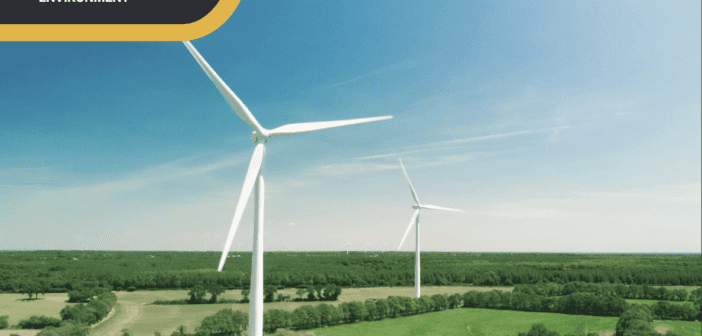Compiled by Angela Mutiso
It has the Potential to Play a Significant Role in Africa’s Energy Future
As an environmentalist, have you ever considered the sheer power of the wind? Have you ever wondered why more people are using it? Wind energy is swiftly becoming the go-to source for renewable energy, and it’s no surprise. Harnessing the power of the wind is not only clean and cost-effective, it is also an abundant resource that has the potential to power millions of homes and businesses worldwide.
In this feature, we look at the importance of wind energy and its potential to revolutionize our energy consumption, reduce carbon emissions, and bring down the cost of electricity. Find out which countries are leading the way in wind power utilization and the exciting possibilities for a sustainable future.
What is wind power?
Wind power is a clean and renewable source of energy that does not produce harmful emissions or pollution. It is therefore a sustainable source of energy that is not expected to run out. As technology improves and production scales up, generating electricity from wind power is progressively becoming more cost-effective and desirable this makes it a financially viable option for meeting our energy needs.
Why do we need wind energy?
As the world continues to grow and evolve, so does its need for energy. Traditional fossil fuels such as coal and oil have been the primary sources of energy for many years. However, these sources of energy have several negative impacts on the environment, including pollution and greenhouse gas emissions. Wind energy is a clean and renewable source of energy that can help reduce the world’s dependence on fossil fuels. Wind is a potent and significant source of renewable energy that has been employed for a long time. As nations look to lessen their reliance on fossil fuels and move toward more sustainable kinds of energy, wind power is now playing a bigger role in the global energy mix.
How does wind help the environment?
One of the most significant advantages of wind power is that it does not produce any greenhouse gas emissions, which contribute to climate change. This makes it a clean and sustainable source of energy. Wind power also helps to preserve natural resources. Unlike fossil fuels like coal, oil, and natural gas, wind power does not require the extraction of finite resources, which helps to preserve these resources for future generations. It reduces air pollution, as it does not produce any harmful pollutants such as sulfur dioxide or nitrogen oxides. This can have positive impacts on both human health and the environment.
Did you know that wind power has some remarkable advantages that make it a great source of
energy? For example, it doesn’t require any water for cooling, making it perfect for regions that are prone to drought. In addition – wind turbines can also provide habitat for certain species of birds and bats, giving them a place to perch or roost. It is exciting to know that wind farms can be designed to promote biodiversity by incorporating features like native grasses, wildflowers, and hedgerows. This can provide habitat for a variety of plant and animal species, making wind farms a hub of thriving ecosystems. Another benefit of wind power is that it can be built on land that is unsuitable for other types of development, like agricultural land that is prone to drought or erosion. This means that there’s no need to clear forests or other natural areas for energy development, preserving the beauty and diversity of our planet. Wind power also reduces the risk of oil spills and other environmental disasters by not requiring the transportation of oil or other fossil fuels. It is generally much quieter than other types of machinery. So, not only does it reduce our reliance on non-renewable energy sources, it can also help reduce noise pollution in certain areas. It can provide economic benefits to local communities, create jobs, generate tax revenue, and reduce energy costs for households and businesses.
Why do we need wind power in Africa?
Africa is home to some of the fastest-growing economies in the world, with a fast expanding population and a growing demand for energy. Wind power can help to meet this demand by providing a clean, sustainable, and affordable source of electricity. Furthermore, many parts of Africa are currently underserved by traditional energy sources, with millions of people lacking access to reliable electricity.
Wind power can help to bridge this energy gap by providing decentralized, off-grid power solutions that can reach even the most remote communities. It can help to reduce Africa’s dependence on fossil fuels, which are often expensive and unreliable.
By investing in wind power infrastructure, African countries can reduce their reliance on expensive imported fuels and strengthen their energy security. It can also help to promote economic development in Africa by creating jobs, stimulating investment, and promoting innovation in the renewable energy sector. So it has the potential to play a critical role in shaping the future of energy in Africa and beyond. Wind is a clean and renewable resource that can be used to produce power without producing any detrimental byproducts. It is also very adaptable and may be utilized for a variety of purposes, from small-scale home generators to massive wind farms that power entire towns.
Which countries have used wind power successfully?
Many countries around the world have successfully incorporated wind power into their energy mix, with some leading the way in terms of installed capacity and innovation. According to the Global Wind Energy Council, the top ten countries for installed wind power capacity in 2020 were:
1. China
2. United States
3. Germany
4. India
5. Spain
6. United Kingdom
7. France
8. Brazil
9. Canada
10. Australia
These countries have all invested heavily in wind power infrastructure and made major progress in reducing their reliance on fossil fuels. Closer home, many African countries have advanced in wind power in recent years, recognizing the potential of this renewable energy source to provide clean and sustainable electricity. Some of the countries that have made significant investments in wind power include:
Egypt – The country has the highest installed capacity of wind power in Africa, with a total capacity of 1.9 GW.
Morocco – The country has a total installed capacity of 1.3 GW, making it the second- largest wind power producer in Africa.
South Africa – The country has a total installed capacity of 1.2 GW, with several wind farms located throughout the country.
Kenya – The country has a total installed capacity of 310 MW, with several wind farms located in Turkana.
Tunisia – The country has a total installed capacity of 245 MW, with several wind farms located in the north and central regions.
Utilizing wind power presents a viable solution to the exorbitant energy costs and inadequate energy access that plagues rural areas bereft of conventional power grids. By enriching the quality of life of those dwelling in such regions, it can further spur economic development. The African continent, in particular, lauds this technological advancement, given its potential to diversify energy sources and enhance energy security, thereby lessening dependence on imported fossil fuels and mitigating the vagaries of global oil prices. Overall, wind power has the potential to play a significant role in Africa’s energy future, providing a clean, sustainable, and reliable source of electricity to meet the growing energy demand.
How would wind bring down the cost of electricity?
Wind power has the potential to bring down the cost of electricity in several ways. It does not require the purchase of any fuel, unlike fossil fuel power plants, which need the constant purchase and transport of coal, oil, or gas. This means that the cost of generating electricity from wind power is largely fixed, with the main expenses being the upfront costs of building and maintaining wind turbines. In addition, wind power can be produced locally, reducing the need for long-distance transmission and distribution infrastructure. This can help to reduce the cost of electricity by avoiding the costs associated with building and maintaining large-scale transmission networks. It can also help to stabilize electricity prices by providing a consistent and predictable source of energy. Unlike fossil fuels, which are subject to price fluctuations and supply disruptions, wind power is a renewable resource that can be harnessed consistently over time.
Finally, wind power can also help to reduce the cost of electricity by creating competition in the
energy market. As more wind power is produced, it can put downward pressure on the cost of electricity, making it more affordable for consumers. While it is not the only solution to our energy needs, it can play a crucial role in reducing greenhouse gas emissions and mitigating the impacts of climate change. Its range of benefits can make it an attractive source of renewable energy for a sustainable future.
The writer is the editorial consultant of the Accountant Journal.
[email protected]




